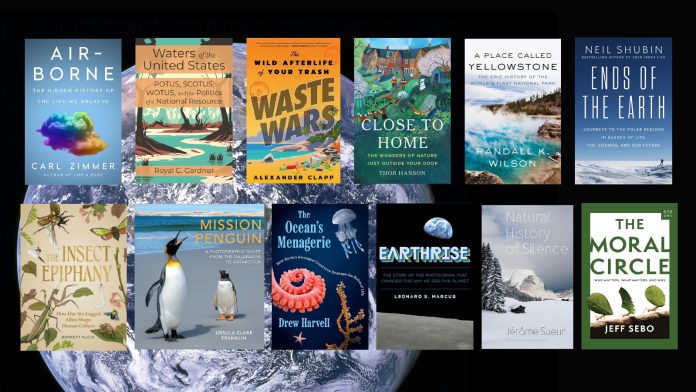From the seeds planted by the first Earth Day celebrated over 50 years ago, an astonishing variety of environmental shoots have sprouted and spread. As a result, an eclectic mix of titles is required to celebrate Earth Month in 2025.
This month’s bookshelf offers four different but related takes on the environmental holiday.
The first take updates readers on the top priorities of the first Earth Day: clean air, clean water, and clean, as in litter-free, land. With cleaner air, New York Times columnist Carl Zimmer observes, it’s easier to detect and survey our “living atmosphere.” The legacy and future endurance of the Clean Water Act of 1972 is the focus of “Waters of the United States.” And “Waste Wars” tracks the now “globalized business of garbage.”
The next three titles examine our proximate relationships with nature: the everyday nature “Close to Home,” the protected nature of our national parks and wilderness areas, including “A Place Called Yellowstone,” and the extreme nature we find at the “Ends of the Earth.”
In protecting places, we try to protect biodiversity, the focus of the third tranche of titles. This year’s selections focus on insects, penguins, and the invertebrate life forms of the deep ocean.
That first Earth Day was prompted, at least in part, by changes in the way we envision and experience nature. “Earthrise” revisits, for young readers, the cultural impact of the color photograph astronaut Bill Anders took of “our planet rising over the lunar horizon.” The silence of Earth in space then leads to the “Natural History of Silence” by eco-acoustic historian Jerome Seur. And our Earth Day bookshelf ends in “The Moral Circle.” Does it make sense, philosopher Jeff Sebo asks, to exclude nature’s creatures from our moral deliberations?
The answer, of course, is “No.” But to deliver on it, we have to value Earth every day of the year.
As always, the descriptions of the titles are adapted from copy provided by their publishers.

Airborne: The Hidden History of the Air We Breathe by Carl Zimmer (Dutton Books 2025, 496 pages, $32.00)
In Air-Borne, award-winning New York Times columnist and author Carl Zimmer leads us on an odyssey through the living atmosphere and through the history of its discovery. We meet the long-forgotten pioneers of aerobiology including William and Mildred Wells, who tried for decades to warn the world about airborne infections, only to die in obscurity. Air-Borne also leaves readers looking at the world with new eyes—as a place where the oceans and forests loft trillions of cells into the air, where microbes eat clouds, and where life soars thousands of miles on the wind. Weaving together gripping history with the latest reporting on COVID and other threats to global health, Air-Borne surprises us on every page as it reveals the hidden world of the air.


Waters of the United States: POTUS, SCOTUS, WOTUS, and the Politics of a National Resource by Royal C. Gardner (Island Press 2025, 312 pages, $45.00 paperback)
In 2023, the Supreme Court made one of its most devastating rulings in environmental history. By narrowing the legal definition of ‘waters of the United States’ (WOTUS), the court opened the floodgates to unregulated pollution. But the decision was also simply the latest in a long series of battles over WOTUS, and what was protected by the Clean Water Act of 1972. Waters of the United States offers the detailed analysis necessary for lawyers or environmental advocates to understand the nuances of water policy, while spinning a compelling narrative for readers who have never cracked a law book. This unique mix of insights into environmental law, history, and politics is required reading for anyone who cares about the future of the nation’s water.


Waste Wars: The Wild Afterlife of Your Trash by Alexander Clapp (Little, Brown & Co. 2025, 400 pages, $32.00)
Dumps and landfills around the world are overflowing. Disputes about what to do with the millions of tons of garbage generated every day have given rise to waste wars waged almost everywhere you look. Some are border skirmishes. Others hustle trash across thousands of miles and multiple oceans. Waste Wars is a jaw-dropping exposé of how and why, for the last forty years, our garbage has spawned a massive, globe-spanning, multi-billion-dollar economy, one that off-loads our consumption footprints onto distant continents, pristine landscapes, and unsuspecting populations. Journalist Alexander Clapp spent two years roaming five continents to report on this world. What, he asks, does the globalized business of garbage say about our world today? About us?


Close to Home: The Wonders of Nature Just Outside Your Door by Thor Hanson (Basic Books 2025, 304 pages, $30.00)
In Close to Home, biologist Thor Hanson shows how retraining our eyes reveals hidden wonders just waiting to be discovered. In Kansas City, migrating monarch butterflies flock to the local zoo. In the Pacific Northwest, fierce yellowjackets placidly sip honeydew, unseen in the treetops. In New England, a lawn gone slightly wild hosts a naturalist’s life’s work. And in the soil beneath our feet, remedies for everything from breast cancer to the stench of skunks lie waiting for someone’s searching shovel. A hands-on natural history for any local patch of Earth, Close to Home shows that we can all contribute to science and improve the health of our planet. Even more, it proves that the wonders of nature don’t lie in some far-off land: they await us, close to home.






